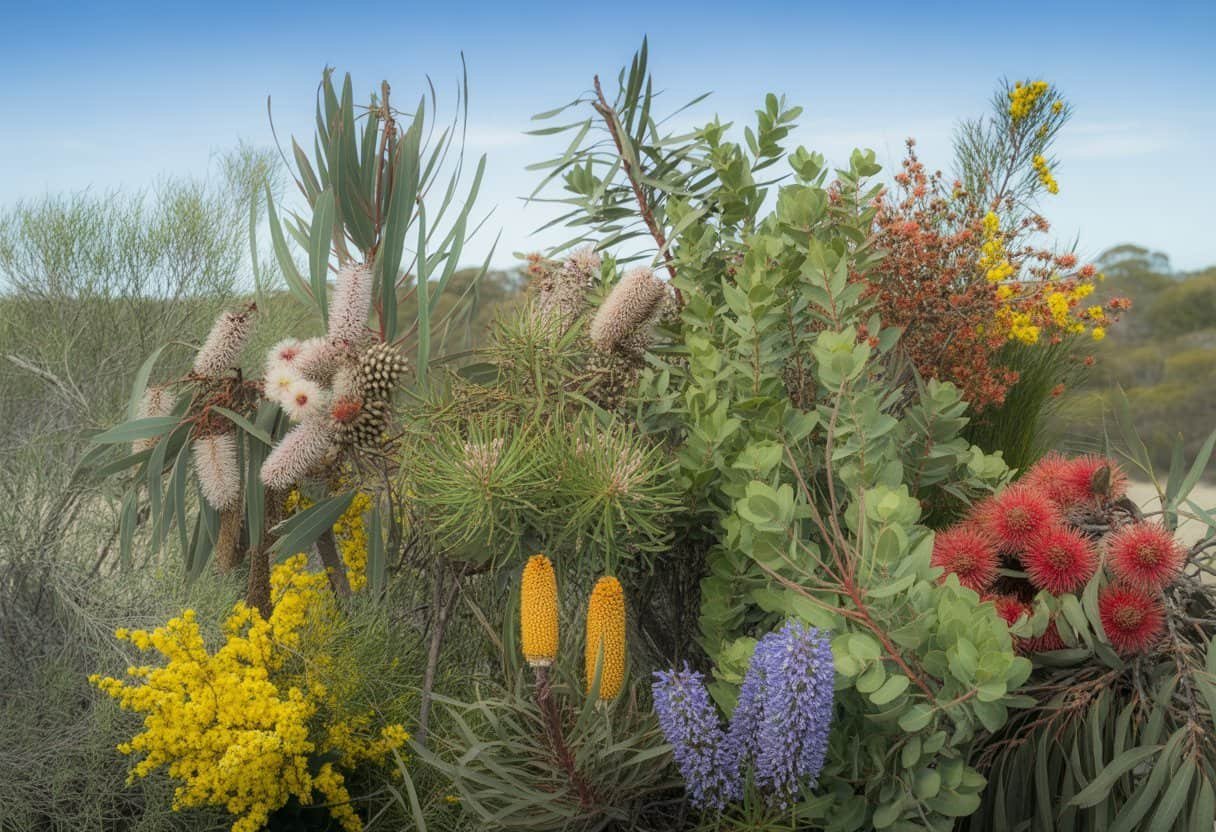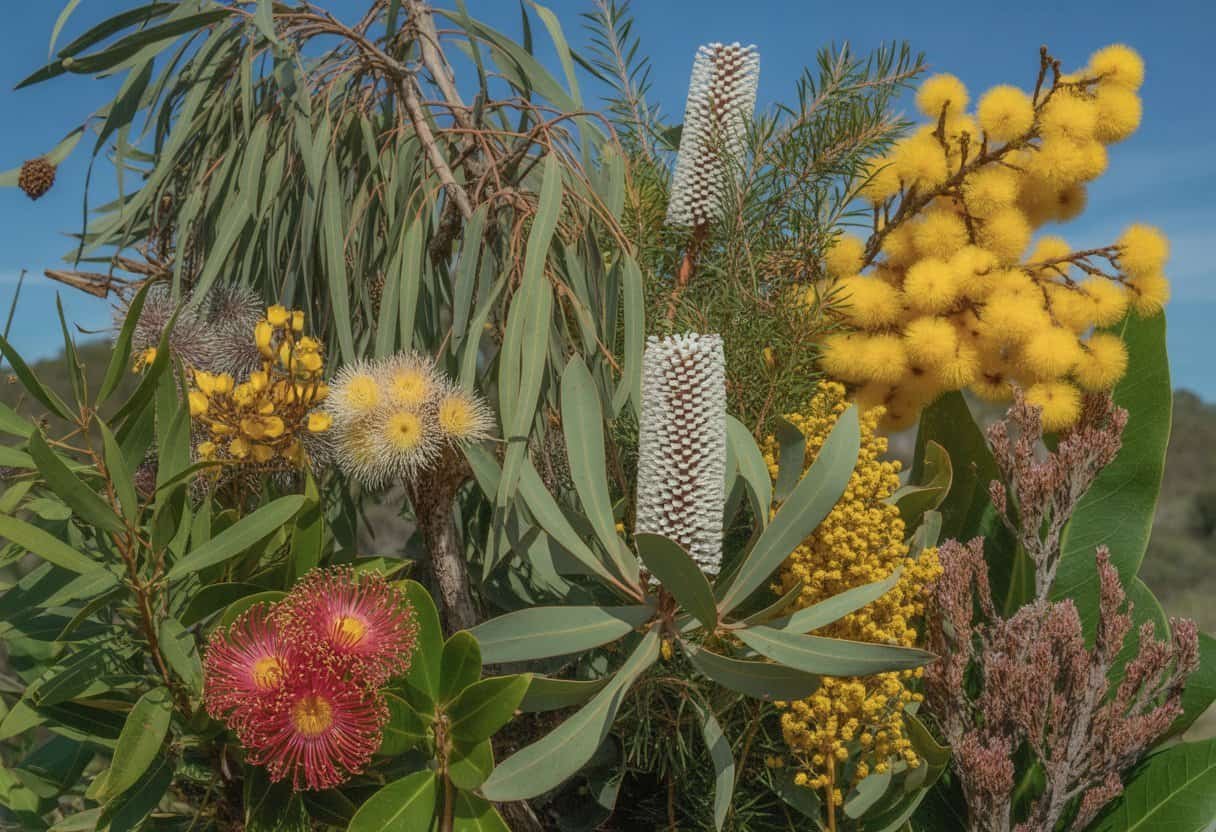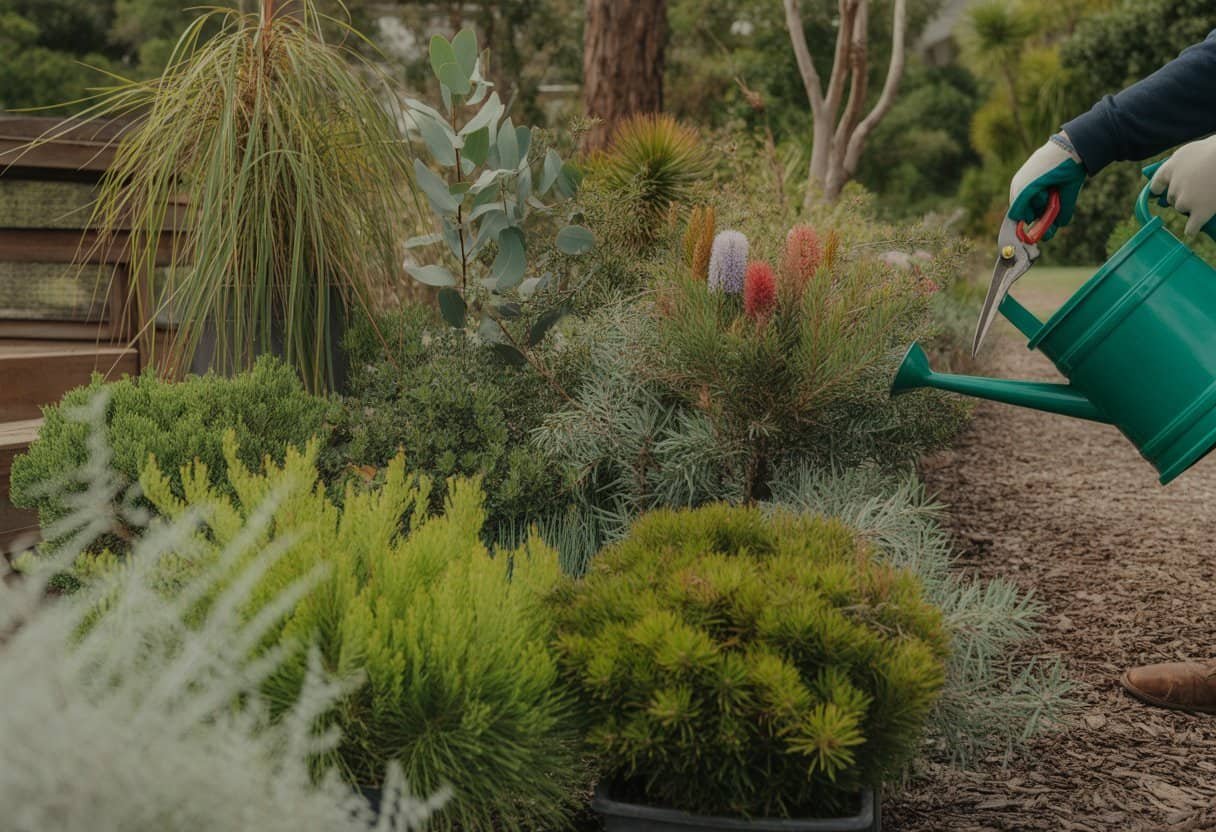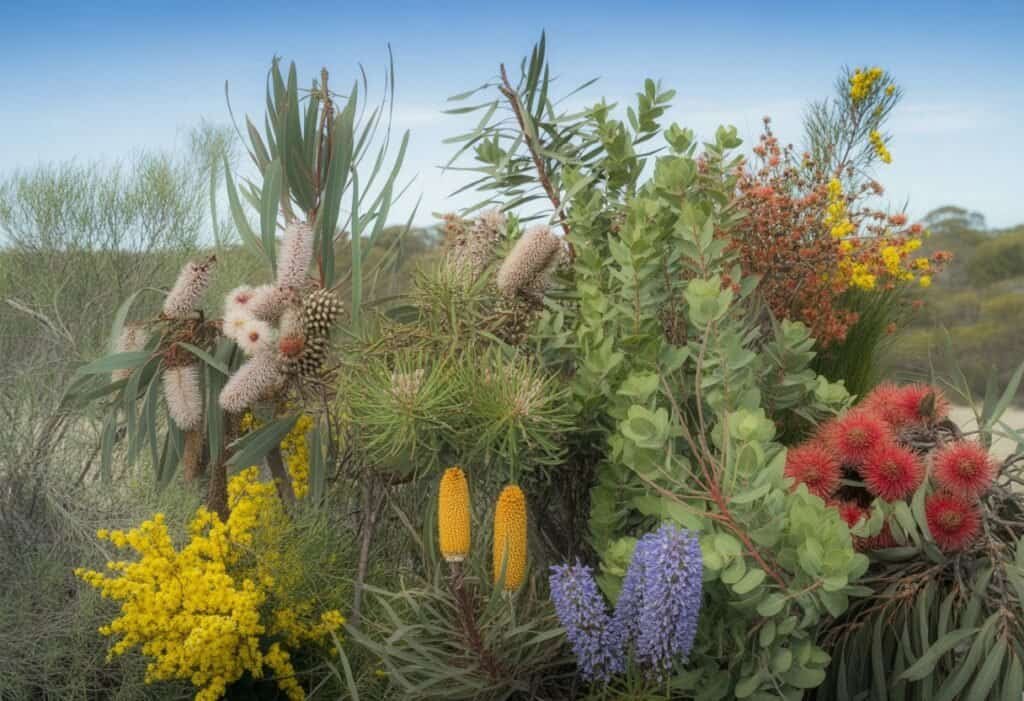Australian native plants showcase the ancient beauty of the world’s driest inhabited continent. These species evolved over millions of years to survive in poor soils and with little water.
Australian native plants are visually striking and need less maintenance than many imported species. They have become popular choices for sustainable gardening.

Australia’s flora includes over 24,000 native plant species, from iconic eucalyptus trees to vibrant bottlebrush flowers. These plants support local wildlife and help maintain ecological balance.
Many Australian homes now feature native gardens. These gardens celebrate native plants, conserve water, and reduce the need for chemical fertilizers.
Key Takeaways
- Australian native plants have adapted to harsh conditions, making them drought-resistant and easy to maintain in gardens.
- The diverse range of native species includes iconic flowering plants like banksias, grevilleas, and kangaroo paws that attract local wildlife.
- Native plants contribute to sustainable landscaping by requiring less water, fewer fertilizers, and providing natural habitats for Australian fauna.
Key Types of Australian Native Plants

Australia’s diverse landscapes have produced a remarkable variety of native plants. These range from towering trees to delicate ground covers, each playing important roles in local ecosystems.
Trees
Eucalyptus trees, or gum trees, dominate Australia’s landscape with over 700 species. Their oil-rich leaves give the Blue Mountains their blue haze.
Acacia trees (wattles) display golden flowers and serve as a national symbol. The Golden Wattle (Acacia pycnantha) is Australia’s floral emblem.
The Brachychiton family includes the Illawarra Flame Tree, which erupts in bright red flowers during spring. These trees often shed their leaves when flowering, creating a vibrant display.
Small trees like the Fan Palm grow well in tropical Queensland. Dwarf varieties of eucalypts suit smaller gardens and provide habitat for native wildlife.
Shrubs and Medium Shrubs
Banksias are distinctive shrubs with cylindrical flower spikes in yellow to red colors. These plants, named after Sir Joseph Banks, provide food for nectar-feeding birds.
Popular native shrubs include:
- Callistemon (bottlebrush) with brush-like flowers
- Grevillea with spider-like blooms in various colors
- Hakea with woody seed pods and protective foliage
- Melaleuca (tea tree) with papery bark and fluffy flowers
Leptospermum (tea tree) and Westringia (coastal rosemary) make excellent hedge plants. The Waratah, with its large red flower heads, is the floral emblem of New South Wales.
Correa, Eremophila, and Boronia are smaller shrubs with bell-shaped flowers. Many Proteaceae family members, including proteas, offer dramatic flowering displays.
Ground Covers and Grasses
Mat-Rush (Lomandra) has tough, grass-like foliage that withstands harsh conditions. These plants work well for erosion control and garden borders.
Kangaroo Grass creates a swaying effect in gardens and provides habitat for small insects. Indigenous Australians traditionally harvested it as a food source.
Pigface (Carpobrotus glaucescens) spreads along coastal areas with succulent leaves and bright pink flowers. This plant helps stabilize sand dunes and serves as bush tucker.
Australian daisies and everlasting daisies add color with minimal water. Billy Buttons feature distinctive yellow spherical flowers on tall stems.
Prostrate plants like dwarf acacias and ground-hugging grevilleas offer excellent soil coverage. Native grasses need less maintenance than introduced species and support local wildlife.
Climbers and Ferns
Pandorea, or Wonga Wonga Vine, produces trumpet-shaped flowers in pink or white. These climbers quickly cover fences or trellises.
Native Clematis grows delicate star-shaped flowers and feathery seed heads. It climbs using its leaf stalks.
Some native climbers, like the Native Grape, produce edible fruits. These plants provide food for birds and shelter for small animals.
Bird’s Nest Fern grows naturally in tree crevices in rainforests. Its broad fronds form a nest-like shape.
Australian tree ferns can grow tall with large spreading fronds. They create a prehistoric look in shaded gardens and need protection from harsh sun and wind.
Many smaller fern varieties thrive in rock crevices and under larger plants. These plants reproduce via spores and have survived since prehistoric times.
Notable Australian Native Flowers
Australian native flowers display incredible diversity and unique adaptations. These blooms have become national symbols and popular garden choices.
Iconic Species
The Waratah (Telopea speciosissima) stands out with large crimson blooms and serves as the floral emblem of New South Wales. Its bright red flower heads consist of many small flowers surrounded by colorful bracts.
Sturt’s Desert Pea features dramatic red and black flowers that thrive in arid conditions. It is South Australia’s floral emblem and holds cultural significance for Indigenous peoples.
The Kangaroo Paw (Anigozanthos) grows fuzzy, paw-shaped flowers in red, yellow, or green. Western Australians have adopted this plant as their floral emblem.
Rock Orchids cling to rocks and trees and produce delicate flowers.
Popular Garden Varieties
The Bottlebrush (Callistemon) has cylindrical flower spikes that resemble bottle cleaning brushes. These blooms attract birds and add vibrant color to gardens.
Grevillea varieties are garden favorites for their spider-like flowers and drought tolerance. They range from ground covers to large shrubs with flowers in red, orange, yellow, and white.
Wax Flowers display delicate star-shaped blooms and a pleasant fragrance. These hardy plants thrive in coastal gardens and provide long-lasting cut flowers.
The Native Fuchsia (Correa pulchella) produces bell-shaped flowers that attract honeyeaters. These plants handle Australia’s dry conditions well.
Lilly Pilly and Dianella are popular for their attractive flowers followed by colorful berries.
Cultivation and Care

To grow Australian native plants successfully, gardeners need to understand their unique needs. These plants have adapted to specific conditions over thousands of years and thrive when you meet their requirements.
Soil and Water Requirements
Most Australian native plants prefer well-draining soil with low phosphorus. Sandy or loamy soils work best for many species.
Test your soil before planting and amend it if needed using native plant mixes from garden centers. Water requirements vary among native species.
New plants need regular watering for the first few months to develop strong roots. Once established, many native plants become drought-tolerant.
Banksias, grevilleas, and other natives from dry regions need little water. Rainforest species require more moisture.
Water deeply but infrequently to encourage deep roots. Mulch with bark or leaf litter to retain moisture, suppress weeds, and add nutrients.
Apply a 5-10cm mulch layer, keeping it away from plant stems to prevent rot.
Pruning and Maintenance
Regular pruning keeps Australian native plants healthy and encourages flowering. Most natives benefit from light pruning after flowering to maintain shape.
When to prune:
- Prune spring-flowering plants after blooms fade.
- Prune winter-flowering species in spring.
- Prune foliage plants anytime growth becomes unruly.
Tip pruning (removing just the growing tips) promotes bushier growth and more flowers. For older plants, prune harder to rejuvenate them.
Gardeners often graft grevilleas and eucalypts to grow species that might struggle in their soil. Use low-phosphorus fertilizers designed for native plants.
Avoid over-fertilizing, as it can harm phosphorus-sensitive species.
Pests and Diseases
Australian native plants usually face fewer pest and disease problems than exotic species. However, some issues can occur.
Common pests include:
- Scale insects
- Borers
- Caterpillars
- Psyllids (especially on eucalypts)
Look for signs like chewed leaves, sticky residue, or distorted growth. Manage minor pest problems with regular hosing or by attracting beneficial insects.
Fungal diseases sometimes appear during humid weather or with poor air circulation. Root rot occurs in poorly drained soils.
Prevent problems with proper planting and maintenance. Protect young plants from possums and birds with light netting if needed.
Australian Native Plants in Landscaping
Australian native plants offer unique benefits for landscape design. Their adaptability and striking appearance make them ideal for gardens.
Landscaping Principles
Once established, native Australian plants need less water and minimal fertilizer. They adapt to local soil conditions, reducing maintenance.
Choose native plants suited to your climate zone. Coastal gardens benefit from salt-tolerant species like Banksia and Westringia, while inland gardens thrive with drought-resistant Acacias and Eucalypts.
Group plants with similar water and sunlight needs together. This method, called hydrozoning, ensures efficient resource use.
Native shrubs like Callistemon (bottlebrush) and Grevillea make excellent borders and focal points. Their flowers attract native birds and insects.
Designing Sustainable Gardens
Sustainable garden design with native plants involves more than plant choice. Add these elements for a thriving garden:
Layered planting – Combine trees, shrubs, and groundcovers for habitat diversity. This approach mimics natural ecosystems and shelters wildlife.
Water management features – Use rain gardens and swales to capture rainfall and direct it to plant roots.
Mulching – Apply a 2-3 inch layer of organic mulch to conserve moisture, suppress weeds, and improve soil.
Australian native gardens suit many styles:
- Formal gardens with clipped Westringia or Syzygium
- Natural bushland styles with informal groupings
- Contemporary designs with architectural plants like grass trees
In small spaces, compact natives like Correa reflexa and Scaevola make a big impact.
Special Adaptations and Ecology
Australian native plants have evolved remarkable survival mechanisms for harsh conditions. These adaptations help them thrive in poor soil, limited water, and frequent bushfires.
Unique Plant Adaptations
Many Australian plants have developed specialized features to survive in challenging environments. Eucalyptus trees have oil-filled leaves that are highly flammable, which helps them during bushfires by eliminating competition.
Some species grow lignotubers, which are woody swellings at the base of the stem. These store energy and nutrients and allow plants to regenerate quickly after fire or drought.
Grass trees (Xanthorrhoea) are distinctive Australian natives with remarkable fire adaptations. They grow extremely slowly—sometimes only 1-2 cm per year—but can live for centuries.
Their thick, fire-resistant trunks protect the growing point during bushfires. Cycads, including the Macrozamia genus, represent ancient plant lineages that have survived for millions of years.
These prehistoric plants have tough, leathery leaves that reduce water loss and resist damage. Many Australian plants have developed sclerophyllous leaves—tough, hard leaves with thick cuticles that reduce water loss in dry conditions.
Ecological Importance
Australian native plants form the foundation of unique ecosystems found nowhere else on Earth. They provide essential habitat and food sources for Australia’s distinctive wildlife.
Many species engage in complex relationships with native animals. Certain plants rely on specific birds, insects, or mammals for pollination and seed dispersal.
Indigenous Australians have used native plants for thousands of years. They have extensive knowledge about which plants provide food, medicine, and materials for tools and shelter.
Native vegetation prevents soil erosion and maintains water quality in Australia’s fragile landscapes. Their deep root systems stabilize soil and filter water.
Propagation and Growth
Australian native plants need specific propagation techniques to thrive in home gardens. Understanding their growth patterns helps gardeners establish healthy specimens.
Seed Collection and Sowing
Seeds from native Australian plants often need special treatment before sowing. Banksias, hakeas, and grevilleas produce woody seed pods that release seeds after exposure to heat or smoke.
This adaptation evolved as a response to bushfires. For best results, collect seeds when pods are mature but before they open.
Store seeds in paper bags in a cool, dry place. Many native seeds benefit from pre-treatment methods:
- Heat treatment: Soak seeds in hot water for 24 hours.
- Smoke treatment: Use commercially available smoke-water solutions.
- Scarification: Gently scratch hard seed coats.
Sowing times vary by species, but most Australian natives prefer spring planting. Use a well-draining seed-raising mix and cover seeds lightly with soil.
Germination may take from 2 weeks to several months.
Cuttings and Grafting Methods
Propagating from cuttings offers a quick way to establish new plants identical to the parent. Semi-hardwood cuttings work best for grevilleas and banksias and should be taken in late spring or early summer.
Prepare cuttings by selecting healthy stems 10-15cm long and removing lower leaves. Dip the cuttings in rooting hormone and place them in a mix of perlite and peat.
Grafting is essential for some grevilleas that struggle on their own roots. This technique joins a desirable plant (scion) to hardy rootstock.
Wedge grafting works well for many native species. Hakeas and banksias can be difficult to root from cuttings, so seed propagation is often preferred.
Commercial nurseries use specialized techniques for these challenging species.
Flowering Season and Growth Cycles
Australian natives display diverse flowering patterns throughout the year. Banksias usually flower in autumn and winter, providing nectar for wildlife when other plants are dormant.
Grevilleas vary widely, with some species flowering year-round and others having specific seasonal displays. Their mature height ranges from ground covers to trees reaching 10 meters.
Most native plants experience active growth during spring and early summer. Pruning after flowering encourages bushier growth and more blooms in the next cycle.
Expected growth rates depend on species and conditions:
| Plant Group | Time to Maturity | Mature Height |
|---|---|---|
| Grevilleas | 2-5 years | 0.5-10m |
| Banksias | 3-7 years | 1-15m |
| Hakeas | 3-6 years | 1-6m |
Water needs decrease as plants establish. Most species require minimal irrigation after the first two years.
Noteworthy Regional Varieties
Australian native plants vary significantly across different regions due to diverse climate conditions and soil types. These regional varieties have unique characteristics that help them thrive in their specific environments.
Eastern Australian Natives
Eastern Australia hosts a wide variety of native plants adapted to higher rainfall and more temperate conditions. Syzygium smithii (formerly Acmena smithii), known as lilly pilly, has glossy leaves and white flowers that develop into pink or purple berries.
This versatile tree grows well in coastal areas and rainforest margins. The NSW Christmas Bush (Ceratopetalum gummiferum) is known for its star-shaped white flowers that develop stunning red sepals during summer.
These plants typically reach 3-5 meters in height and thrive in the sandstone soils around Sydney. Austromyrtus dulcis (Midyim Berry) is a low-growing shrub that produces edible white-spotted purple berries.
Native to coastal areas of Queensland and New South Wales, it makes an excellent ground cover. Doryanthes excelsa (Gymea Lily) is an iconic eastern species with sword-shaped leaves and tall flowering spikes up to 4 meters high.
Western and Central Australian Species
Western and central Australian natives have evolved adaptations to survive harsh, arid conditions with minimal rainfall. These plants often have water-storing tissues, deep root systems, reduced leaf surfaces, and heat-reflective foliage.
Finger lime (Citrus australasica) varieties from these regions are more compact and drought-resistant than their eastern relatives. Their unique caviar-like pulp is popular in gourmet cooking.
Sturt’s Desert Pea (Swainsona formosa) displays striking red and black flowers against silvery foliage. This ground-covering plant survives extreme temperature fluctuations common in central Australia.
Grass trees (Xanthorrhoea species) in western regions grow slowly but can live for centuries. Their distinctive black trunks result from bushfires, which stimulate flowering in these resilient plants.
Australian Native Edibles and Utilitarian Plants
Australia’s landscape offers unique plants that provide both food and practical materials. Indigenous communities have relied on these native species for thousands of years and developed extensive knowledge about their uses.
Edible Native Plants
The Australian bush contains many edible plants with distinctive flavors and nutritional benefits. The finger lime (Citrus australasica) stands out as a gourmet native food, containing caviar-like pearls of tangy pulp.
These small fruits grow on thorny shrubs in rainforest areas of Queensland and New South Wales. Macadamia nuts are Australia’s most famous food export.
Native to Queensland and New South Wales rainforests, these creamy nuts grow on evergreen trees and contain healthy fats. Other important edible natives include:
- Bush tomato: Small desert fruits with intense flavor
- Wattleseed: Protein-rich seeds used in baking and beverages
- Muntries: Apple-flavored berries on low shrubs
- Quandong: Red fruits also called “native peach”
These foods have become popular in modern Australian cuisine and appear in high-end restaurants and specialty food products.
Plants with Cultural or Practical Uses
Indigenous Australians developed knowledge about plants for tools, medicine, and cultural practices. Paperbarks (Melaleuca species) provided materials for food wrapping and shelter construction.
Tea tree (Melaleuca alternifolia) produces antimicrobial oils used for thousands of years to treat skin conditions and infections. Today, tea tree oil appears in many commercial products.
Grass trees (Xanthorrhoea) served multiple purposes in traditional societies. Their resin made excellent adhesive for tool-making, and flower spikes created fire-starting tools.
Eucalyptus species provided medicinal benefits through aromatic oils. These plants also supplied hardwood for tools, weapons, and construction.
Spinifex grass allowed desert communities to create water-carrying vessels and housing materials in harsh environments.
Frequently Asked Questions
Many gardeners and plant enthusiasts have common questions about growing and maintaining Australian native plants. These answers address selection, care, and sourcing of Australia’s unique flora.
What are the most popular Australian native plants for garden landscaping?
Banksia, Grevillea, and Callistemon (bottlebrush) are among the most popular Australian natives for landscaping. These plants offer striking flowers and attract native birds and insects.
Kangaroo Paw (Anigozanthos) provides dramatic color with its fuzzy, paw-shaped blooms in red, yellow, and green. It adds visual interest to garden beds.
Eucalyptus trees and Leptospermum (tea tree) species are widely used for screening and structure in native gardens. Their varied sizes suit different garden spaces.
Which Australian native flowers are the most well-known?
The Golden Wattle (Acacia pycnantha), Australia’s national floral emblem, is perhaps the most iconic Australian flower. Its bright yellow blooms appear in late winter and early spring.
Waratah (Telopea) with its dramatic red flower heads is a symbol of New South Wales. These blooms make a bold statement in gardens and floral arrangements.
Flannel Flower (Actinotus helianthi) features soft, star-shaped white blooms with a velvety texture. Its beauty and cultural significance make it popular.
How can Australian native plants be used for indoor decoration?
Cut stems of Eucalyptus add texture and fragrance to floral arrangements. Their silvery-blue foliage remains attractive for weeks in water or dried for long-term displays.
Banksia flower spikes make striking focal points in arrangements. After flowering, their seed pods can be dried and used in permanent displays.
Small potted Correa (native fuchsia) and Scaevola (fan flower) thrive indoors in bright spots. These compact plants bring Australian native beauty inside.
Where can one purchase Australian native plants and seeds?
Specialized native plant nurseries offer a wide selection of Australian plants and expert advice. Many have online catalogs for convenient ordering.
Botanical gardens throughout Australia hold plant sales, especially in spring and autumn. These events often feature rare native species not found in commercial nurseries.
Local garden centers increasingly stock popular native varieties. Community garden groups and native plant societies also organize plant swaps and sales throughout the year.
Can Australian native plants thrive in a variety of climates and soils?
Australian natives have adapted to diverse conditions across the continent, from tropical regions to alpine areas. This natural diversity means suitable species exist for almost any growing condition.
Many species tolerate poor soils with excellent drainage, making them ideal for challenging garden sites. Plants from coastal regions often show good salt tolerance.
Match species selection to local conditions for best results. Plants from similar rainfall patterns and soil types to your garden will establish more successfully.
What are the maintenance requirements for Australian native shrubs and plants?
Most Australian natives need minimal watering once established. You should provide extra water only during long dry periods.
Prune after flowering to maintain shape. This also encourages dense growth.
Many species respond well to hard pruning when you need to rejuvenate them.
Use fertilizer sparingly, and choose products made for native plants. Standard garden fertilizers often have too much phosphorus for Australian species.


